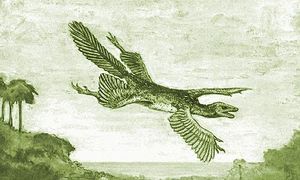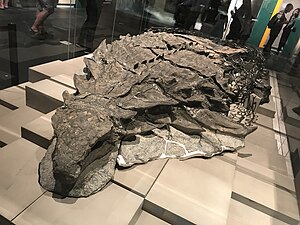Mesozoic Era of Great Kiravia

The Mesozoic Era of Great Kiravia is defined as an era as encompassing the Triassic, Jurassic and Cretaceous Periods on the continent of Great Kiravia, lasting from about 252 to 66 million years ago.[1] Often referred to as the "Age of Reptiles",[2] it is characterized by the dominance of archosaurian reptiles such as the dinosaurs, an abundance of gymnosperms (such as ginkgoales, bennettitales) and ferns, a hot greenhouse climate and the tectonic break-up of Pangaea. The period is defined geologically as beginning with the first appearance of the Conodont Hindeodus parvus and ending with an Iridium enriched layer associated with a major meteorite impact in modern-day Daxia and subsequent K-Pg extinction event. It is also sometimes referred to as the "Age of Conifers" in Great Kiravia due to the abundance of fossilized material from coniferous trees.[3]
Great Kiravia is unique in the Mesozoic for being an island continent with only very little outside contact following the Pangaea-Kiravia split at the end of the Triassic period.[4] With basal clades of pterosauromorphs, theropods, sauropodomorphs and ornithischians already inhabiting Great Kiravia at the time of the split however, these were able to evolve and diversify independently of archosauromorphs elsewhere, resulting in numerous examples of convergent evolution with otherwise very distantly related genera but also many examples of island gigantism, island dwarfism and notably of Bergmann's rule.[5] Evolution on the continent of Great Kiravia was heavily influenced by its three distinct biomes; a volcanic nearly arctic climate in the far north, a temperate highly arboreal climate in the south and a major riparian border zone in-between the two characterized by rolling plains and river deltas.[6]
Despite a relatively limited number of clades of synapsids, dinosauromorphs and pterosauromorphs occupying Great Kiravia following the Triassic–Jurassic extinction event, the paleobiological diversity of Great Kiravia appears to be only slightly weaker than that of Sarpolevantia in the advent of the Cretaceous, suggesting a rapid and diverse evolutionary process had taken place during the Jurassic to fill all the niches left open by the T-J event.[7] At least one clade of small Kiravian theropods appear to have evolved powered flight independently of their Sarpolevantine counterparts during the late Jurassic period; there is also physical paleontological evidence of feathers in many theropods of various sizes in Great Kiravia, lending further evidence to the theory that feathers are ancestral to archosaurian reptiles.[8] Like the rest of the world, the Cretaceous period ended when the K-Pg extinction event occured following a major meteor striking central Daxia, causing the mass extinction of all non-avian dinosaurs and most other tetrapods weighing more than 25 kilograms (55 pounds).
Geologic periods
Following the Paleozoic, the Mesozoic extended roughly 186 million years, from 251.902 to 66 million years ago when the Cenozoic Era began. This time frame is separated into three geologic periods; from oldest to youngest:
- Triassic (252 to 201 million years ago)
- Jurassic (201 to 145 million years ago)
- Cretaceous (145 to 66 million years ago)
Triassic (252 to 201 million years ago)
The early Triassic period of Great Kiravia is thought to have been largely similar to that in Triassic Levantia as the two were directly connected. Synapsids and sauropsids would have diversified greatly during this period,[9] with the synapsid clade known as therapsids evidently establishing themselves as highly succesful towards the end of the Triassic period. Early dinosauromorphs migrated to Kiravia in the late Triassic and began competing with the therapsids for resources and thus evolutionary success. The eruption of the supervolcano Gimænbayer in modern day Sauropod Oblast, Kiravia, is widely agreed by paleontologists to have ended the Triassic period and facilitated the Triassic–Jurassic extinction event which led to the extinction of most of, if not all, non-therapsid synapsids leading to the rise of the dinosaurs[10] and ultimately heralded the dislodgement and separation of the continent of Great Kiravia from Pangaea.[11]
Jurassic (201 to 145 million years ago)


The early Jurassic of Great Kiravia showed major diversification of dinosauromorphs as theropods, sauropodomorphs and ornithischians came to compete over the numerous evolutionary niches left open by the extinction of the non-therapsian synapsids.[12] The testudosauroids of Kiravia, a clade of armoured ornithischian dinosaurs also known from Sarpolevantia and Audonia, evolved into the thagomizeroids during the middle Jurassic, a clade that would prove itself very prolific in Great Kiravia until the K-Pg extinction event. The paleobiology of Jurassic Kiravia appears to have adapted to that of the continent's biomes; small, arboreally capable theropods and ornithischians would have roamed the dense forests of southern Kiravia alongside mammaliaformes, while in the riparian belt of central Kiravia, larger herbivorous dinosaurs like ornithischians and dwarf sauropods would have inhabited the river deltas alongside medium-sized[13] theropods. The north of Jurassic Great Kiravia would have been home to the larger of the previously described sauropods and more hardy ornithischians such as thagomizeroids, notably the eponymous Thagomizersaurus. These would have lived in and around the fertile valleys that surrounded the countless active volcanoes of northern Kiravia such as the Gimænbayer Plains.
One obvious reason that the animals in the north were larger than their southern counterparts is that of the square-cube law which describes the relationship between the volume and the surface area of an animal or object. According to the square-cube law, animals with large physical volume for their surface area are more efficient at maintaining body heat, allowing them to better function in northern Kiravia. Similarly and in keeping with Bergmann's rule, this in all likelyhood also drove carnivore evolution towards larger physical sizes, together with being better able to take down the resultant larger prey in the north. At least two local extinctions are thought to have occured in northern Kiravia as a result of volcanic activity during the late Jurassic[14] leading to localized extinction events. Following d'Everard's rule, new lineages of ornithischians, sauropods and theropods would step up to replace the extinct genera, often from within the same clades as those that had gone extinct.[15]
The late Jurassic Kiropteryx is the earliest known genus of Kiravian theropod dinosaur that paleontologists agree was a powered flier. Having evolved from previous gliding dinosaurs, Kiropteryx was the first definite proof of dinosaurs having independently evolved powered flight multiple times. The late Jurassic is also notable for the diversifying of the thagomizeroids that seemed to thrive in the riparian belt of central Kiravia.
Cretaceous (145 to 66 million years ago)

Placing a definite point for the boundary between Jurassic and Cretaceous periods in Great Kiravia has been difficult because of the strong regionality of most biostratigraphic markers and the lack of any chemostratigraphic event such as that provided by the eruption of Gimænbayer which caused the Triassic–Jurassic extinction event. Somewhat arbitrarily, the border has been placed at 145 million years ago by Yonderian paleontologist Hieronymous Bergmann.[16][17]
The early Cretaceous is marked by a major diversification of small theropods and ornithischians migrating to the riparian belt of central Kiravia. The paleobotany of the region appears to have changed in the period towards more leafy materials more easily digestible by small unspecialized browsers. This migration and change in vegetation is thought to be the main cause for the extinction of several lineages of thagomizeroid species during the early Cretaceous, having been outcompeted by the more rapidly breeding and growing ornithischians. Paleontological evidence suggests however that the north of Kiravia did not change much during the early Cretaceous and that it continued to be inhabited by sauropods, large ornithischians like thagomizeroids (notably Thagomizersaurus) and the theropods that preyed on them.[18]
During the late Cretaceous, the continent of Great Kiravia collided with the North Pole forming Kiroborea. This increased volcanic activity in the region, causing a number of minor local extinctions as evidenced by the layers of basalt and obsidian in the region. Towards the very late Cretaceous (c. 70-66 million years ago), the large thagomizeroid dinosaur Ĥosaurus rexkiraviensis was abundant in both the northern and riparian central regions of Great Kiravia, living alongside a wide variety of ornithischian and smaller theropod dinosaurs.[19] There is good evidence to support another major eruption of the supervulcano Gimænbayer around 66 million years ago, not unlike the Triassic–Jurassic extinction event, which would have undoubtedly caused major waves of extinction within the Great Kiravian paleoecologic system. It is ultimately considered a contributing factor to the ultimate Cretaceous–Paleogene extinction event which occured when a major meteor struck central Daxia, causing the mass extinction of something resembling 75% of all life on Earth.[20][21]
Volcanic activity
The north of Great Kiravia is and was home to numerous volcanoes, five of which are or have at one time been considered supervolcanoes, notably Gimænbayer in Sauropod Oblast whose two major eruptions c. 201 million years ago and 66 million years ago are thought to either directly have caused or contributed to mass extinctions. The Gimænbayer Plains is an area that consists of numerous layers of solidified flood basalt that together are more than about 2,000 metres (6,600 ft) thick, cover an area of about 500,000 square kilometres (200,000 sq mi), and have a volume of about 1,000,000 cubic kilometres (200,000 cu mi). Originally, the Gimænbayer Plains may have covered about 1,500,000 square kilometres (600,000 sq mi), with a correspondingly larger original volume[22]
See also
Notes
- ↑ All times given by the Gregorian calendar unless otherwise stated.
- ↑ A term coined by Bergendii polymath Gideon-Raphael Mantelleaux in 1843.
- ↑ Balboa, Maximus: A comprehensive history of paleontology, pg. 3. 2004.
- ↑ The exception being marine reptiles and intercontinental ocean-going pterosaurs like Quetzalcoatlus.
- ↑ Bergmann's rule, named for Yonderian paleontologist Hieronymous Bergmann, states that populations and species of larger size are found in colder environments, while populations and species of smaller size are found in warmer regions.
- ↑ Konsaháken, Vurdhan: Paleogeology of Great Kiravia, University of Belarus, pg. 14-19. 2012.
- ↑ Lyukquar, Ansar: Kiravia and the Mesozoic, pg. 67-69. 2015.
- ↑ Balboa, Maximus: A comprehensive history of paleontology, pg. 104. 2004.
- ↑ Few species have been excavated from the early Triassic of Kiravia because of a lack of access to appropriate dig sites.
- ↑ Paleontologists agree that both groups were already being outcompeted by dinosauromorphs but disagree on the extent.
- ↑ Fürster, Johann: Mammalian derivation of the Permian period, pg. 169-172. 1999.
- ↑ The therapsians at this time being limited almost entirely to mammaliaformes.
- ↑ "Medium-sized" meaning no larger than 1 tonne (2,200 lb).
- ↑ Based largely on basalt deposits.
- ↑ Lyukquar, Ansar: Kiravia and the Mesozoic, pg. 26-35. 2015.
- ↑ Balboa, Maximus: A comprehensive history of paleontology, pg. 11. 2004.
- ↑ Lyukquar, Ansar: Kiravia and the Mesozoic, pg. 8. 2015.
- ↑ Lyukquar, Ansar: Kiravia and the Mesozoic, pg. 81-88. 2015.
- ↑ Lyukquar, Ansar: Kiravia and the Mesozoic, pg. 102-107. 2015.
- ↑ Konsaháken, Vurdhan: Paleogeology of Great Kiravia, University of Belarus, pg. 4-5 + 49-53. 2012.
- ↑ Balboa, Maximus: A comprehensive history of paleontology, pg. 204-206. 2004.
- ↑ Konsaháken, Vurdhan: Paleogeology of Great Kiravia, University of Belarus, pg. 59-69. 2012.